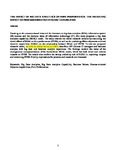Big data analytics and firm performance: Effects of dynamic capabilities
| dc.contributor.author | Wamba, SF | |
| dc.contributor.author | Gunasekaran, A | |
| dc.contributor.author | Akter, S | |
| dc.contributor.author | Ren, SJ-F | |
| dc.contributor.author | Dubey, R | |
| dc.contributor.author | Childe, SJ | |
| dc.date.accessioned | 2016-10-03T10:09:38Z | |
| dc.date.issued | 2017-01-01 | |
| dc.identifier.issn | 0148-2963 | |
| dc.identifier.issn | 1873-7978 | |
| dc.identifier.uri | http://hdl.handle.net/10026.1/5544 | |
| dc.description.abstract |
Drawing on the resource-based view and the literature on big data analytics (BDA), information system (IS) success and the business value of information technology (IT), this study proposes a big data analytics capability (BDAC) model. The study extends the above research streams by examining the direct effects of BDAC on firm performance (FPER), as well as the mediating effects of process-oriented dynamic capabilities (PODC) on the relationship between BDAC and FPER. To test our proposed research model, we used an online survey to collect data from 297 Chinese IT managers and business analysts with big data and business analytic experience. The findings confirm the value of the entanglement conceptualization of the hierarchical BDAC model, which has both direct and indirect impacts on FPER. The results also confirm the strong mediating role of PODC in improving insights and enhancing FPER. Finally, implications for practice and research are discussed. | |
| dc.format.extent | 356-365 | |
| dc.language | en | |
| dc.language.iso | en | |
| dc.publisher | Elsevier BV | |
| dc.subject | Big data analytics | |
| dc.subject | Big data analytics capability | |
| dc.subject | Business values | |
| dc.subject | Process-oriented dynamic capabilities | |
| dc.subject | Firm performance | |
| dc.title | Big data analytics and firm performance: Effects of dynamic capabilities | |
| dc.type | journal-article | |
| dc.type | Article | |
| plymouth.author-url | https://www.webofscience.com/api/gateway?GWVersion=2&SrcApp=PARTNER_APP&SrcAuth=LinksAMR&KeyUT=WOS:000388053500037&DestLinkType=FullRecord&DestApp=ALL_WOS&UsrCustomerID=11bb513d99f797142bcfeffcc58ea008 | |
| plymouth.issue | C | |
| plymouth.volume | 70 | |
| plymouth.publication-status | Published | |
| plymouth.journal | Journal of Business Research | |
| dc.identifier.doi | 10.1016/j.jbusres.2016.08.009 | |
| plymouth.organisational-group | /Plymouth | |
| plymouth.organisational-group | /Plymouth/Faculty of Arts, Humanities and Business | |
| plymouth.organisational-group | /Plymouth/Faculty of Arts, Humanities and Business/Plymouth Business School | |
| plymouth.organisational-group | /Plymouth/REF 2021 Researchers by UoA | |
| plymouth.organisational-group | /Plymouth/REF 2021 Researchers by UoA/UoA17 Business and Management Studies | |
| plymouth.organisational-group | /Plymouth/Users by role | |
| plymouth.organisational-group | /Plymouth/Users by role/Academics | |
| dcterms.dateAccepted | 2016-08-05 | |
| dc.rights.embargodate | 2018-2-9 | |
| dc.identifier.eissn | 1873-7978 | |
| dc.rights.embargoperiod | Not known | |
| rioxxterms.versionofrecord | 10.1016/j.jbusres.2016.08.009 | |
| rioxxterms.licenseref.uri | http://www.rioxx.net/licenses/all-rights-reserved | |
| rioxxterms.licenseref.startdate | 2017-01-01 | |
| rioxxterms.type | Journal Article/Review |


